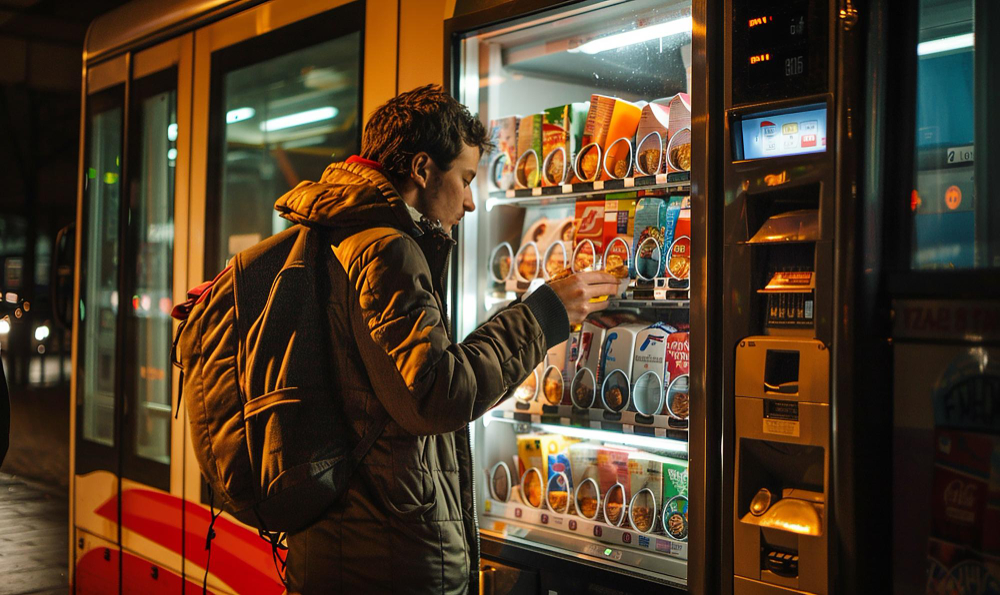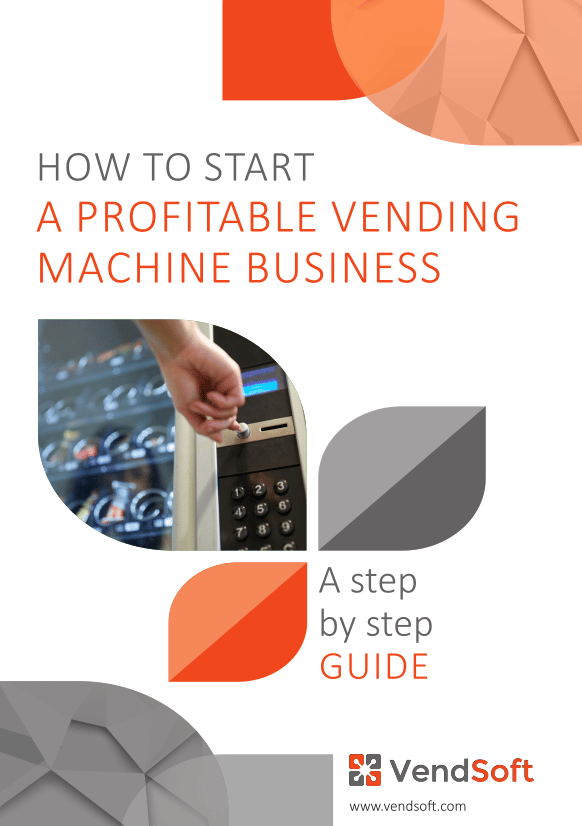Discover how vending machines work—from the moment you insert money to the delivery of your snack. This article breaks down the mechanics behind modern machines and shows how VendSoft helps operators manage inventory, sales, and maintenance more efficiently.

Every day, millions of people walk up to a vending machine, make a quick selection, grab a snack or drink, and go on with their day. It’s so fast and simple, we barely give it a second thought.
But behind that smooth, 10-second transaction is a small world of technology, logistics, and precision timing. If you’re a vending operator—or curious about getting into the business—the vending machine business is a growing and innovative industry, driven by automation, technology, and smart location strategies. It’s worth knowing what really goes on inside the machine and how modern tools like VendSoft help make it all run smoothly.
This article is a deep dive into how vending machines work, exploring the technology and science behind every transaction.
Let’s pop the hood and take a look.
Introduction to Vending Machines
Vending machines have become a staple of modern retail, offering customers a fast and convenient way to purchase everything from snacks and drinks to electronics and personal protective equipment. Whether you’re grabbing a quick snack between meetings or picking up essentials on the go, vending machines are designed to fit seamlessly into our busy lives. The vending machine industry has seen remarkable growth, with the global retail vending machine market valued at $74.54 billion in 2025 and projected to grow at a 3.7% CAGR through 2030 (reaching ~$89.27 billion by 2030).
This surge is fueled by the evolution of modern vending machines, which now feature advanced technology like internet connectivity, cashless payment systems, and real-time inventory tracking. These innovations have made machines more efficient, reliable, and user-friendly than ever before. As technology continues to advance, vending machines are becoming an increasingly important part of the retail landscape, meeting the needs of customers and businesses alike with unmatched convenience and flexibility.
Types of Vending Machines
Vending machines come in a variety of shapes and sizes, each designed to meet different customer needs and business goals. The most familiar are snack vending machines, which dispense a wide selection of snacks such as chips, cookies, and candy bars—perfect for satisfying cravings on the go. Drink machines are another popular option, offering everything from sodas and juices to bottled water, making it easy to stay refreshed throughout the day.
For those looking for something more advanced, smart vending machines are leading the way. These high-tech machines feature internet connectivity, interactive touchscreens, and cashless payment options, allowing them to dispense not just snacks and drinks, but also electronics, cosmetics, and even hot meals. Specialty machines like beer vending machines and pizza vending machines are also gaining traction, especially in high-traffic areas like airports, post offices, and Las Vegas casinos. With the rise of smart vending, the possibilities for what a vending machine can offer are expanding rapidly, making them a versatile solution for businesses and a convenient choice for customers.
1. The Front-End Experience: Press, Pay, Pick-Up
It starts with a simple interface. Vending machines now accept payments through a variety of methods, including cash, coins, card payments, and mobile wallets. Modern machines are equipped with a card reader to process credit or debit card transactions, making it easy for customers to use their preferred payment method. The payment system in modern machines can also accept bills, including dollar bills and paper currency, and uses magnetic ink, magnetic sensors, and electromagnetic properties to authenticate paper money. Unlike older machines that relied on simpler coin mechanisms, modern machines accept a wider range of payment options and can provide exact change.
Once the machine accepts the payment, the user presses a code or taps a screen to make a selection, and customers automatically receive their selection as the machine dispenses products.
From there, a quick mechanical process kicks in to vend the product: either a spiral coil rotates to begin dispensing the item, a robotic arm delivers it, or a conveyor gently moves it to the pickup area. Product dispensing is managed by advanced systems, and some machines use QR codes for contactless payments. Some machines even use sensors to confirm that the item was successfully dropped into the pickup area—no more shaking the machine! Snack machines and snack vending machines use coin and bill recognition technology to process payments and ensure the correct amount is received.
2. The Mechanics Behind the Magic
Inside the machine, each snack or drink sits in its designated spot. The vending machine functions as a mechanical device, operating through motors and mechanisms. When a selection is made, that item is released by a small motor and guided down a chute or belt.
Many machines include built-in refrigeration or heating systems depending on what’s being sold—whether it’s a cold soda, a warm meal, a fresh sandwich, hot meals, or hot food. These systems maintain the right temperature while keeping energy use in check. Snack vending machines, which focus on snacks and shelf-stable foods, are also common in the industry.
3. How Machines Know What’s Inside
You might wonder: how does a vending machine “know” when it’s out of chips or when a candy bar hasn’t sold in weeks?
The answer lies in internal tracking systems. Sensors and tracking software monitor stock levels and use inventory tracking to keep tabs on product availability. These systems can automatically update inventory in real time for the operator, recording every sale and ensuring you don’t need to be on-site to know how your machine is performing—smart vending has taken over.
4. Software: The Brain Behind the Operation
VendSoft is designed to help you streamline your vending operations by connecting to your telemetry devices and card readers. Once the integration is set up, VendSoft automatically pulls real-time sales and machine data so you can:
Monitor machine performance and status remotely
Track sales, inventory levels, and cash collections
Generate optimized service routes based on machine needs and location
Use dynamic picklists to prepare exactly what needs restocking before each trip
With accurate, real-time data coming in, you can eliminate unnecessary visits, restock more efficiently, and make smarter decisions across your operation.
Managing machines without telemetry?
VendSoft can still work for you. You can enter inventory, refill, and sales data manually—and still benefit from picklists, route optimization, and inventory control features. It’s a flexible solution whether you’re starting small or managing a full-scale fleet.
Internet Connectivity: The Digital Lifeline
Internet connectivity has become the backbone of the modern vending machine industry, transforming how machines operate and how customers interact with them. Today’s vending machines are equipped with advanced technology such as light sensors, robotic arms, and temperature sensors to ensure that products are dispensed accurately and efficiently. The integration of near field communication (NFC) technology means that customers can use Apple Pay, Google Pay, and other contactless payment options, making transactions faster and more secure.
For vending machine operators, internet connectivity offers powerful benefits. Machines can update inventory in real time, alerting operators when stock is low or when maintenance is needed. This remote monitoring capability reduces the need for frequent site visits, streamlining operations and cutting costs. Automated solutions powered by smart vending technology are meeting the increasing demand for convenience and efficiency, allowing businesses to deliver a better customer experience while optimizing their vending operations. As the industry continues to evolve, internet-connected vending machines are setting new standards for reliability, flexibility, and customer satisfaction.
5. Restocking and Maintenance: The Human Touch
Of course, machines still need human support. When snacks are running low, your drivers get restocking lists. Thanks to tracking software, they don’t have to guess what to bring—they already know the correct amount of each product needed for restocking.
If a coin gets stuck or a product jams, operators are alerted and can send a technician directly, minimizing downtime and lost sales.
Security: Keeping Snacks and Data Safe
When it comes to vending machines, security is about much more than just keeping snacks safe—it’s about protecting your business, your customers, and their data. Modern vending machines are equipped with a host of advanced security features designed to safeguard both the products inside and the sensitive information processed during every transaction.
Today’s smart vending machines use secure payment systems that accept credit or debit cards, as well as digital wallets like Apple Pay and Google Pay. These payment systems rely on encryption and tokenization, ensuring that customer data is protected from unauthorized access. By working with secure payment processors and following industry standards for data protection, vending machine operators can give customers peace of mind every time they grab a quick snack.
Physical security is just as important. Many machines are built with reinforced doors, secure locking mechanisms, and robust construction to deter theft and vandalism. Security features like cameras, motion sensors, and anti-theft alarms help monitor activity around the machine and can alert operators to any suspicious behavior. Some smart vending machines even offer GPS tracking and remote monitoring, so operators can keep tabs on their machines from anywhere and respond quickly if there’s a problem.
The vending machine industry is also embracing cutting-edge technologies such as biometric authentication and artificial intelligence-powered security systems. These innovations help prevent unauthorized access and add an extra layer of protection for both the machine and the customer’s data.
6. One Machine, a Whole Operation
A vending machine might look like a stand-alone unit, but in reality, it’s part of a much larger system. Retail stores are popular locations for vending machines, providing convenient access to snacks and other products for customers. Vending machines exist in a wide variety of locations and serve many different purposes, from snacks and beverages to specialty foods. How vending machine work involves coordination between supply chains, software, and equipment—every item that drops into a pickup bin is the result of smart planning, reliable equipment, and modern software.
And when you’re managing dozens—or hundreds—of machines, businesses rely on organization and technology to manage their vending operations. Staying organized isn’t optional. It’s essential.
Conclusion: A Lot More Than Just Snacks
Next time you grab a granola bar or bottle of water from a vending machine, take a second to think about the system behind that moment. What seems like a simple transaction is actually the final step in a finely tuned process powered by technology, logistics, and smart decision-making.
And for operators using tools like VendSoft, it’s easier than ever to run that system smoothly—and profitably.
Want more vending business tips?
Subscribe to our free 2-week email course and learn how to start a successful vending business.

